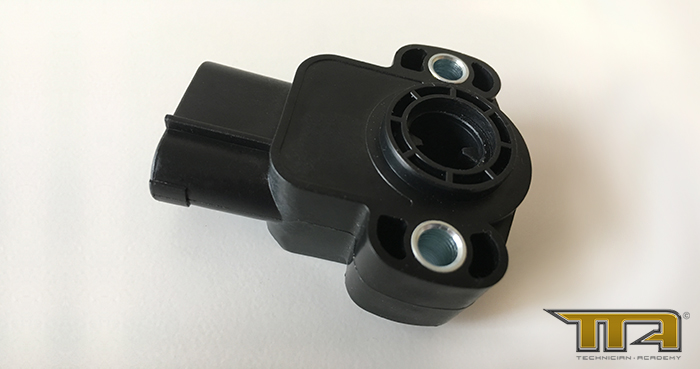The powertrain control module (PCM), which controls virtually every function of the engine and automatic transmission, depends upon an input signal from the TPS (among other things) to calculate fuel delivery and ignition timing strategy. Without the input from the TPS, it would be impossible for the OBD-II controlled engine to minimize harmful exhaust emissions while maximizing fuel efficiency and optimizing performance.
As a type of potentiometer, the TPS is capable of providing the PCM with a voltage signal that varies according to the position of the throttle plate. Typically the outside of the sensor is firmly mounted so that the center of the sensor may rotate inside of it. The TPS is mounted to the throttle body in such a manner as to allow the throttle plate shaft to protrude into the middle of the sensor body and rotate the potentiometer dial whenever the throttle is opened or closed by the driver.
Reference voltage (usually 5-volts) is applied to one pin of the TPS; accompanied by a ground to a second pin and a signal wire to a third pin. As the throttle is opened, and the center of the TPS rotates, circuit voltage increases. As the throttle is closed, voltage decreases. The PCM recognizes these variations in circuit voltage as changes in throttle position and initiates the steps necessary for the engine to operate at its maximum efficiency and performance level. Typically, TPS circuit voltage ranges between .5-volts (at idle) and 5.0 volts (at wide open throttle).
Adjustable TPS
Some TPS systems incorporate an adjustable sensor. When this is the case, the outer portion of the sensor is manufactured with some type of slotted mounting system so that the sensor may be rotated slightly before being secured in place by the mounting bolts.
When an adjustable TPS is replaced, a digital volt/ohmmeter (DVOM) must be used to ensure that it is adjusted correctly. Here are a few quick tips for a successful replacement of your adjustable TPS:
- Make sure that the throttle bore and throttle plate are clean and free from obstruction before installing the new TPS and attempting to make initial adjustments.
- Remove the defective TPS and mount the new TPS, leaving the mounting bolts hand tight.
- With the ignition key on and the engine off (KOEO), connect the positive test lead of the DVOM to the signal wire of the TPS; connect the negative test lead to the TPS ground or any other battery ground.
- Have an assistant hold the accelerator pedal firmly on the floor while you observe the DVOM voltage display. Gently rotate the TPS until the voltage reading is as close to .5-volts as possible. Tighten the TPS mounting bolts according to manufacturer’s torque specifications and release the accelerator pedal.
- With the DVOM still connected, have your assistant press the accelerator pedal all the way to the floor and hold it. Observe the DVOM display. If it is between 4.5 and 5-volts, the TPS is working properly and any TPS malfunction should be rectified.
Non-Adjustable TPS
Increasingly becoming more common than the adjustable TPS, is the non-adjustable TPS. Unlike the adjustable variety, the non-adjustable component is loaded with a strong spring that returns it to the closed throttle position when released.
While the non-adjustable TPS will not require adjustment, it will require some finesse in order to install it properly. As with the adjustable TPS, you will need to make sure that the throttle plate and bore are clean and in good working order. After removing the faulty TPS, gently press the pivot of the new TPS against the appropriate end of the throttle plate shaft. Open the throttle slowly until the shaft is aligned correctly with the sensor. Once the two are aligned, just insert the mounting bolts and torque them to manufacturer’s specifications. You may use a diagnostic scanner or a DVOM to ensure that the new TPS is functioning as intended.
TPS in the Drive-by-Wire System
In today’s environmentally responsible atmosphere, automakers are choosing to use drive-by-wire throttle systems more than ever. By eliminating the need for a cable actuated, mechanically operated throttle plate, harmful exhaust emissions can be reduced farther even if it takes place at the (slight) expense of performance.
Drive-by-wire systems are designed to utilize at least one sensor on the accelerator pedal arm. This sensor monitors the position of the accelerator pedal arm and provides the PCM with an input voltage signal reflecting such. The PCM, in turn, initiates a voltage signal to the throttle body actuator motor. The actuator motor(s) serve to open and close the throttle plate as desired.
In this case, the TPS performs similarly to that of the cable actuated throttle plate system but is much more important to overall throttle operation.
In most cases, the drive-by-wire system utilizes a pair of accelerator pedal sensors and a pair of throttle position sensors. Some manufacturers incorporate both sensors into normal operation while others designate one as the primary and the other as the secondary and they function as such.
Elimination of the accelerator cable and its mechanical design allows the PCM to receive an input voltage signal directly from the accelerator pedal. The TPS continues to function as previously mentioned; providing the PCM an input voltage signal reflective of throttle plate position (sometimes measured in percentage). By receiving a voltage input that is reflective of throttle position sooner, the PCM is capable of calculating a more effective strategy for ignition timing and a more efficient one for fuel delivery.
At this stage in drive-by-wire development, many automakers offer only a single option for TPS replacement – complete throttle body replacement. This can be beneficial for diagnostic purposes but financially inconvenient in some instances.
Here are a few generic tips for TPS testing:
- Use the DVOM to test reference voltage and ground at the TPS connector (KOEO).
- Connect the DVOM to the TPS signal wire (positive test lead) and TPS ground wire (negative test lead) behind the TPS connector (with the connector plugged-in, KOEO) while slowly opening and closing the throttle to check for glitches in the sensor. Voltage should increase and decrease smoothly and without spikes and/or other irregularities.
- Ensure that the throttle plate is closing properly by testing for minimum TPS voltage with the throttle closed. If not, the throttle plate and bore may need to be cleaned.

